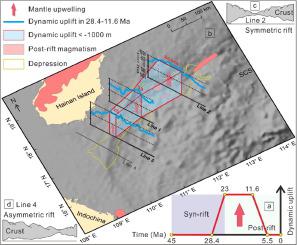Gondwana Research ( IF 7.2 ) Pub Date : 2022-06-11 , DOI: 10.1016/j.gr.2022.06.001 Zhongxian Zhao , Zhen Sun , Xiaoxi Zhu , Penggao Fang , Jie Liao , Liheng Sun , Zhe Zhang

|
Complex subduction system surrounding the South China Sea (SCS) region drove vigorous mantle upwelling, however, its time and pattern are not well constrained. Hot mantle upwelling induced broad OIB-type volcanisms, caused dynamic uplift, altered basin subsidence and was consecutively recorded by strata in the SCS region. The northwest SCS margin is located in the center of diffusive igneous provinces and featured by significant subsidence anomaly and along-strike variable rifting styles and magmatism, being an ideal place to explore the time-space variations in dynamic uplift and mantle upwelling, and reveal the effects on continental rifting and magmatism via seismic interpretation, strain rate calculation and residual subsidence analysis. Results show that the margin experiences two stages of extension during the syn-rifting period (45-23 Ma), a slow strain rate (1.5e-15 to 3.5e-15) in 45-28.4 Ma and a fast, eastward increasing strain rate (4e-15 to 7e-15) in 28.4-23 Ma. Subsidence analysis reveals that the entire margin initiated dynamic uplift and mantle upwelling at ca. 28.4 Ma, then increased to ca. 23 Ma, during which continental stretching and faulting were promoted, but the syn-rifting subsidence was inhibited. In the post-rifting period, mantle upwelling remained vigorous in 23-11.6 Ma, then decayed in 11.6-5.5 Ma to generate a fast post-rifting subsidence. Spatially, the dynamic uplift of more than 1 km has a long bar shape with the wider side in the east sub-basin, implying stronger mantle upwelling occurring in the east, which well explains why higher strain rates, more symmetric rifts and intense post-rifting magmatism (23-11.6 Ma) appeared in the east. Combined with plate reconstructions, it is inferred that the mantle return flow induced by slab subduction of the proto-SCS and the following SCS caused the mantle rising in the northwest SCS margin.
中文翻译:

南海西北部边缘动态隆升与深部地幔上涌的时空变化:大陆裂谷与岩浆作用的新认识
围绕南海(SCS)地区的复杂俯冲系统驱动了强烈的地幔上升流,但其时间和模式并未受到很好的限制。热地幔上涌诱发了广泛的OIB型火山作用,引起了动态隆升,改变了盆地沉降,并被南海地区地层连续记录。南海西北缘地处弥散型火成岩省的中心,沉降异常明显,沿走向变裂谷样式和岩浆活动,是探索动力隆升和地幔上涌时空变化的理想场所。通过地震解释、应变率计算和残余沉降分析对大陆裂谷和岩浆作用的影响。结果表明,在同裂谷期(45~23 Ma),边缘经历了两个伸展阶段,在 45-28.4 Ma 时应变率缓慢(1.5e-15 到 3.5e-15),在 28.4-23 Ma 时应变率快速向东增加(4e-15 到 7e-15)。沉降分析表明,整个边缘在 ca 时开始了动态隆起和地幔上涌。28.4 Ma,然后增加到 ca。23 Ma, 大陆伸展和断裂活动得到促进, 但同裂陷沉降受到抑制。裂谷后期地幔上升流在23~11.6 Ma保持旺盛,11.6~5.5 Ma衰变,产生了快速的裂谷后沉降。空间上,1 km以上的动力隆起呈长条状,东次盆地一侧较宽,表明东部发生强烈的地幔上涌,这很好地解释了为什么更高的应变率、更对称的裂谷和强烈的后-东部出现裂谷岩浆作用(23-11.6 Ma)。











































 京公网安备 11010802027423号
京公网安备 11010802027423号